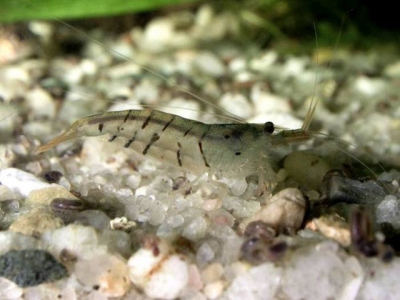Feed ingredient increases post-larval shrimp survival, weight gain
Initial studies doubled post-larval survival rate and increased weight gain by 50 percent.
 Europeans need a new shrimp narrative
Europeans need a new shrimp narrative Consequently, and led by the two bastion species of the sector – black tigers (Penaeus monodon) and Pacific whites (Litopenaeus vannamei)
 Shrimp farmers flock to data sharing project
Shrimp farmers flock to data sharing project Over 150 Thai shrimp farmers have signed up to a new collaborative data collection and sharing project that has been launched in a bid to reduce the impact
 Shrimp diseases - Dystrophy of muscle & hepatopancreas (Loose Shell Syndrome)
Shrimp diseases - Dystrophy of muscle & hepatopancreas (Loose Shell Syndrome) Loose shell syndrome (LSS) of farmed shrimp has been reported from many parts of the world and is recognized as a major disease problem causing significant
 Shrimp diseases - Nutritional Diseases- Poor and reduced growth
Shrimp diseases - Nutritional Diseases- Poor and reduced growth The yield of shrimps is directly proportional to the quantity and quality of feed consumed by them. The quality refers to the presence of all the nutrients
 Shrimp diseases - Blackening of gills ( black death disease)
Shrimp diseases - Blackening of gills ( black death disease) This disease, called black death or shrimp scurvy occurs in penaeids that are reared in culture systems lacking algae and receiving diets with insufficient
 Microsporidian impacts shrimp production
Microsporidian impacts shrimp production Enterocytozoon hepatopenaei (EHP), a microsporidian parasite that has been widely found in Asia and other parts of the world, is impacting aquaculture productio
 Shrimp diseases - Cramped Tail Condition
Shrimp diseases - Cramped Tail Condition This occasionally observed condition of penaeid shrimp has been reported to occur in the summer months when both air and water temperatures are high.
 Mineral extract reduces EMS, WSSV impacts in Pacific white shrimp
Mineral extract reduces EMS, WSSV impacts in Pacific white shrimp Some antimicrobial compounds appear to disrupt bacterial communication that activates genes associated with release of toxins
 Shrimp diseases - Fungal diseases
Shrimp diseases - Fungal diseases The common disease causing fungi are Lagenidium, Siropodium, Haliphthoros and Fusarium. Environmental factors such as rainy season, humid condition
 Understanding shrimp hemocytes Part 2
Understanding shrimp hemocytes Part 2 Shrimp producers seeking to improve the profitability of their crops must be aware of external factors that may affect the survival and growth of their shrimp
 Understanding shrimp hemocytes Part 1
Understanding shrimp hemocytes Part 1 Shrimp producers seeking to improve the profitability of their crops must be aware of external factors that may affect the survival and growth of their shrimp
 Use algorithms to calculate feed for Pacific white shrimp
Use algorithms to calculate feed for Pacific white shrimp Shrimp aquaculture has a great impact on Ecuador’s national economy. As of July 2018, cumulative shrimp harvests had reached 289,431 metric tons (MT) and $1,868
 Emerging disease: Shrimp Hemocyte Iridescent Virus (SHIV)
Emerging disease: Shrimp Hemocyte Iridescent Virus (SHIV) A newly discovered iridescent virus that causes severe disease and high mortality in farmed Pacific white shrimp (Litopenaeus vannamei) in Zhejiang, China
 New nested PCR test targets gene specific to farmed shrimp pathogen EHP
New nested PCR test targets gene specific to farmed shrimp pathogen EHP The microsporidium Enterocytozoon hepatopenaei (EHP) infects penaeid shrimp and has been considered a critical threat to shrimp aquaculture, causing serious
 Breakthrough sale for shrimp sustainability initiative
Breakthrough sale for shrimp sustainability initiative Ecuador's Sustainable Shrimp Partnership (SSP) has today signed off its first batch of approved farmed shrimp exports.
 Testing soy-optimized feeds and automated feeding systems in shrimp pond production Part 2
Testing soy-optimized feeds and automated feeding systems in shrimp pond production Part 2 Shrimp are grazers with limited capacity to store feed in their digestive tract, which results in slower continued ingestion of small quantities of feed
 Testing soy-optimized feeds and automated feeding systems in shrimp pond production Part 1
Testing soy-optimized feeds and automated feeding systems in shrimp pond production Part 1 Shrimp are one of the most valuable traded seafood items, and the Pacific white shrimp (Litopenaeus vannamei) is the preferred shrimp species for aquaculture
 Shrimp given plasma can grow almost 10% bigger, study finds
Shrimp given plasma can grow almost 10% bigger, study finds Feed components supplier, Darling Ingredients, has released new research that it says demonstrated nearly 10% growth in shrimp fed with plasma.
 Management of non-hazardous solid waste in shrimp farms
Management of non-hazardous solid waste in shrimp farms The concept of “non-hazardous solid waste” is the generic name of any type of residual product that can be solid, semi-solid and generally
